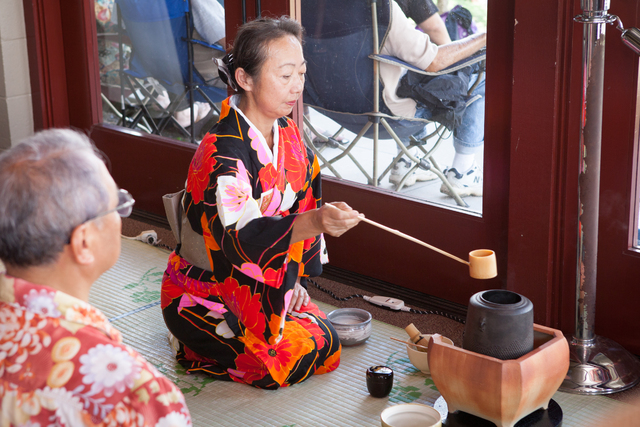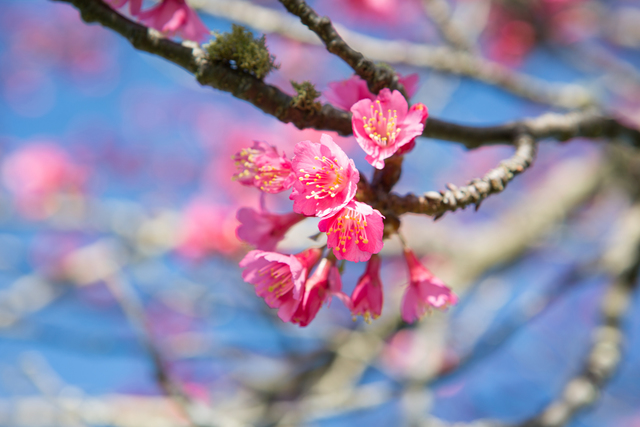Waimea Cherry Blossom Heritage Festival still growing strong
More than two decades ago rumors of a bypass being built rumbled through Waimea.
Local community member, the late James Tohara and other longtime Kohala residents decided this wouldn’t be good for their town. So they came up with a plan to have a cherry blossom festival to celebrate Waimea’s unique blend of the Japanese immigrant heritage with the local Hawaiian people and the intricate hybrid these two cultures have developed together in Kohala. Tohara called up George Yoshida, then-director of the Hawaii County Department of Parks and Recreation, voicing his concerns for their community, their idea for a festival and whether the county help. Twenty minutes later, the planning began.
The bypass, now favored by many in Waimea, is yet to be built. But the festival is going strong.
“This all happened in a single telephone call,” said Roxcie Waltjen, the cultural education administrator for the parks department. “This could never happen like this nowadays. But within a year. The first festival took place.”
Waltjen had been on the job only five days when that first Waimea Cherry Blossom Heritage Festival made its debut. The festival marks the blooming of the historic cherry trees at Church Row Park and celebrates the age-old Japanese tradition of hanami, which translates to “cherry blossom viewing party.” After a seasonal winter chill, the trees typically are blooming in early February.
“We had only seven vendors,” Waltjen remembered. “We used a lowboy trailer as a stage. There was some food, some historical displays and a bonsai booth. About 400 people attended. But in all, it seemed a bit gloomy.”
Waltjen decided she wanted to liven things up a bit. The day after that festival she sat down with the 16 or so community volunteer planners and said: “Let’s do more.” They all agreed. More booths, more food, more activities.
“In those days, there was no water or electricity in Church Row Park,” Waltjen said. “So we got HELCO to raise a pole for electricity in the park and a plumber to run a line of water to the festival grounds just for that day. The day after the festival, both the water and electricity was removed till the next year.”
In 1997, the circus tent that was used to house the now 40 vendor booths of the festival suddenly blew away.
“We thought the festival would have to be cancelled,” Waltjen said. “But the churches all opened their doors to the vendors and events, and the festival was saved that year, after all.”
The next year, Waltjen and her fellow community planners decided they needed a new location because the wind in the park could be very strong and unpredictable, and the festival was outgrowing its grounds. Parker Ranch was a part of the planners group, so behind the Parker Ranch Center was a natural next step.
“Suddenly, people were coming out of the woodwork to participate,” she said. “Historic homes were opening up to host tea ceremonies, craftspeople and food booths were approaching us completely unsolicited. Banks were even offering ‘cherry blossom’ loans.”
Now Waltjen and her cohorts had a new challenge. Traffic. The festival was overwhelming the streets and parking of Waimea town. Yet another community group came to the rescue. Roberts Hawaii donates two buses during the festival each year. Anyone attending the festival can park at one site, and simply hop on the free shuttle that visits all the festival’s sites. When attendees are done, the shuttle takes them back to their car.
Today, the Waimea Cherry Blossom Heritage Festival features 250 vendors at multiple sites throughout Waimea, including Church Row Park, the Parker Ranch Shopping Center, Kahilu Theatre, Mana Christian Ohana Church, the Ginger Farm, and more — wherever you see the pink banner.
Visitors from all over the world, including Russia, Iceland, Europe, Austrailia and New Zealand, join the 35,000 people who turn out for the festivities.
“The great success of this festival is due to it being a perfect example of community agencies, private enterprises and local government all working together in partnership for the common good of our community,” said Waltjen.
All the events are child-friendly and encourage interaction between demonstrators and attendees. This year’s festival takes places on Saturday, from 9 a.m. to 3 p.m., and is dedicated to the Waimea Bonyu Kai Bonsai Club and the Waimea Arts Council. The dedication ceremony will be at the opening of the festival at the main entertainment stage to the rear of the Parker Ranch Center.
Gov. David Ige, Mayor Billy Kenoi, Consul General of Japan Yasushi Misawa and Hawaii Council Representative Margaret Wille are among the dignitaries expected to attend.
The 2016 event artwork is a photograph by Barbara Schaefer, “Imiola Church.” The photo will appear on a limited number of collector posters available for $10 at the Waimea Arts Council’s Firehouse Gallery.
Info: 961-8706








